Raabe J. Hydro power - the design, use, and function of hydromechanical, hydraulic, and electrical еquipment
Подождите немного. Документ загружается.

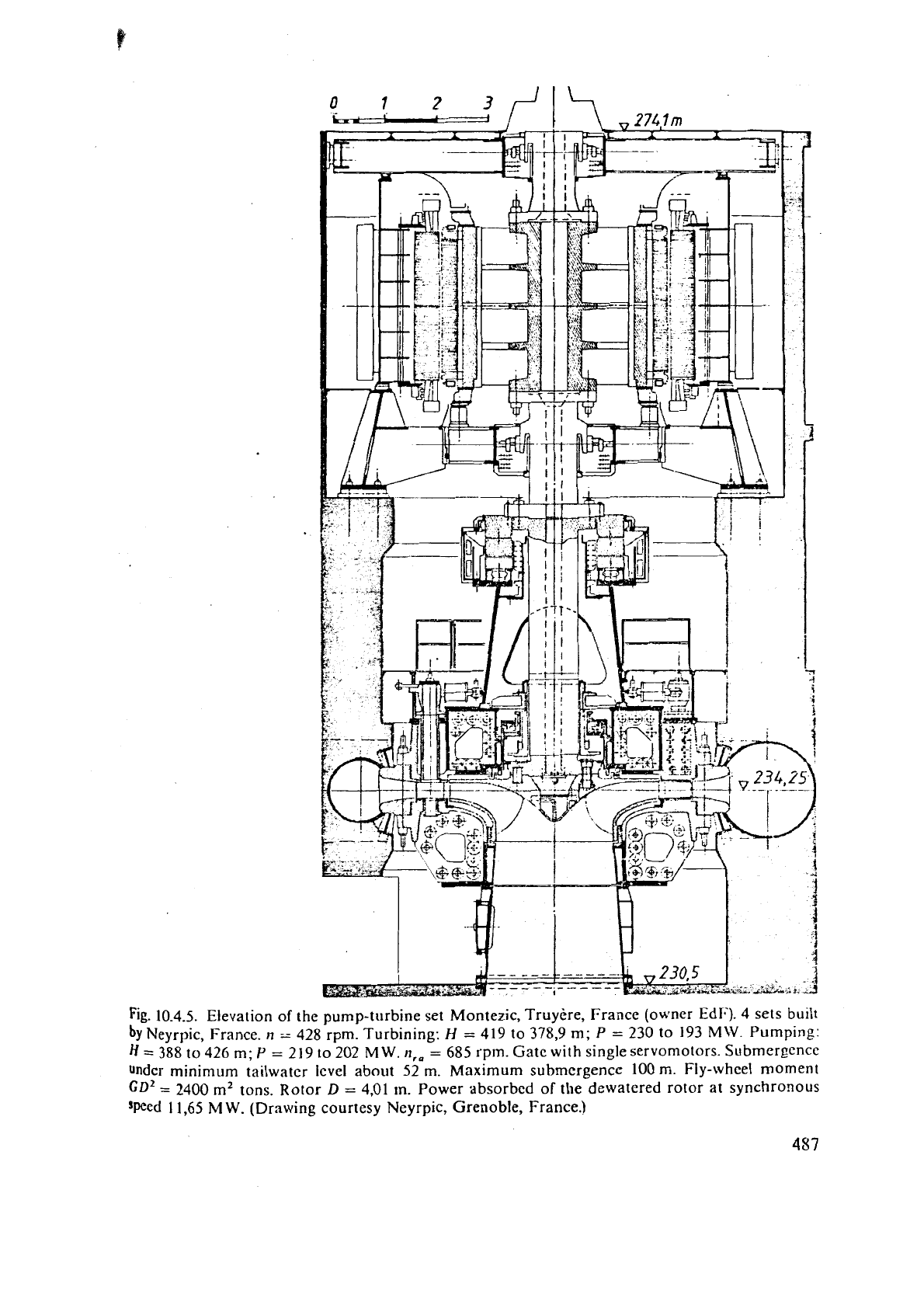
Fig.
10.4.5.
Elevation of the pump-turbine set Montezic, Truylre, France (owner EdJ:).
4
sets built
by
Neyrpic, France.
n
-
428
rpm. Turbining:
H
=
419
to
378,9
m;
P
=
230
to
193
MW.
Pumping:
=
388
to
426
rn;
P
=
2
19
to
202
M
W.
rr,,
=
685
rpm. Gate with single servomotors. Submergence
under minimum tailwater level about
52
m.
Maximum submergence
100
n;.
Fly-wheel momenr
GDZ
=
2400
m2 tons. Rotor
D
=
4,01
m.
Power absorbed of the dewatered rotor at synchronous
'Peed
11,65
MW. (Drawing courtesy Neyrpic, Grenoble, France.)
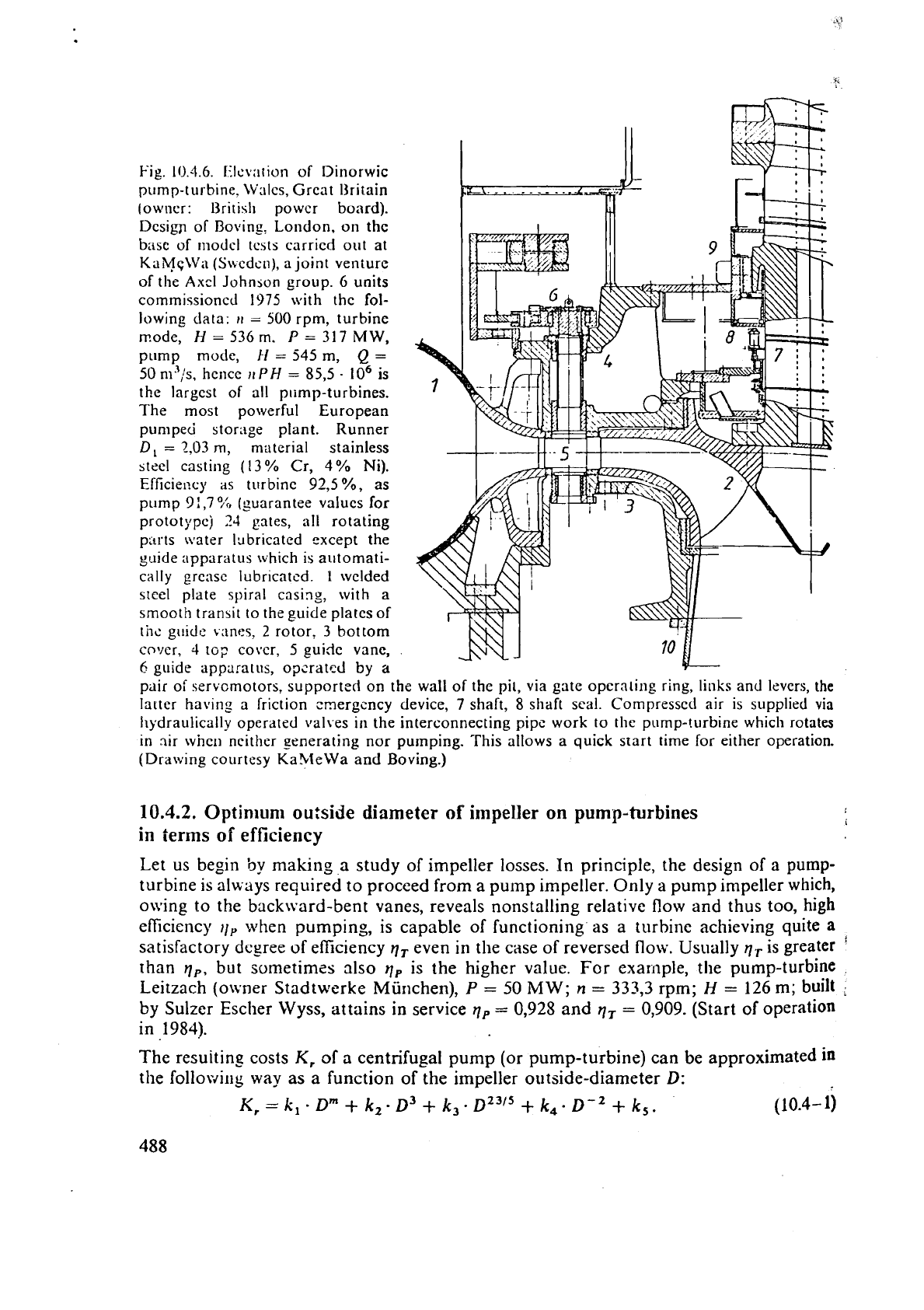
Fig. 10.4.6. Elcv:irion of Dinorwic
pump-turbine,
\Vales,
Great 13ritain
(owncr: firitis11 power board).
Dcsigp of Boving, London,
on
thc
bast
of
II~O~C~
tests
carricd out at
Kai\.IqWa
(S\vcdcn), a joint venture
of the
Axcl Johnson group.
6
units
comrnissioncd
1975
with the fol-
lowing data:
tr
=
500
rpm, turbine
mode,
H
=
536
m.
P
=
31
7
MW,
piimp mode,
I-!
=
545 m,
Q
=
50 rn3/s, hcncc
ltPH
=
85,5
.
lo6
is
the largest of all pimp-turbines.
The most powerful European
pumped storage plant. Runner
D,
=
2,03
rn,
material stainless
steel casting
(13%
Cr,
4%
Ni).
Efficiei?cy
as
ti~rbine 92,5
%,
as
pump
9:,7
0/<,
(guarantee valucs for
prototypcj
34
gates, all rotating
parts
water lubricated except the
guide apparatus which is automati-
cally
grensc
lubricated.
1
welded
steel plate spiral casing, with a
smooth
transit to the guide plates of
thc
guide
vanes,
2
rotor,
3
bottom
cover,
4
tcj?
covcr,
5
guide
vane,
6
guide apparatus, opcratcd
by
a
pair of servomotors, supportect on the wall of the pit, via gate opernling ring, links and levers, the
latter hauins a friction cmergcncy device,
7
shaft, 8 shaft seal. Compressed air is supplied via
hydraulically operated
val1.e~ in the interconnecting pipc work to the pump-turbine which rotates
in
nir when neither generating nor pumping. This allows a quick start time for either operation.
(Drawing courtesy
KaMeWa and Boving.)
10.4.2.
Optin~un~
outside diameter
of
impeller on pump-turbines
in
terms
of
efficiency
Let us begin
by
making
a
study of impeller losses. In principle, the design of a pump-
turbine is always required to proceed from a pump impeller. Only a pump impeller
which,
owing to the backward-bent vanes, reveals nonstalling relative flow and thus too, high
efficiency
11,
when pumping, is capable of functioning as a turbine achieving quite
a
satisfactory degree of efficiency
q,
even in the case
of
reversed
flow.
Usually
q,
is
greater
'
than
q,,
but sometimes also
q,
is the higher value. For example, tlie pump-turbine
Leitzach (owner Stadtwerke Miinchen),
P
=
50 MW;
n
=
3333
rprn;
H
=
126
m; built
a
by
Sulzer Escher Wyss, attains
in
service
q,
=
0,925 and
rl,
=
0,909. (Start of operation
in 1984).
The
resuiting costs
K,
of
a
centrifugal pump (or pump-turbine) can be approximated
in
the followirig
way
as
a
function of the impeller outside-diameter
D:
K,
=
k,
Dm
+
k,.D3
+
k3. D23/5
+
k4-
D-~
+
kg.
(10.4-
1)
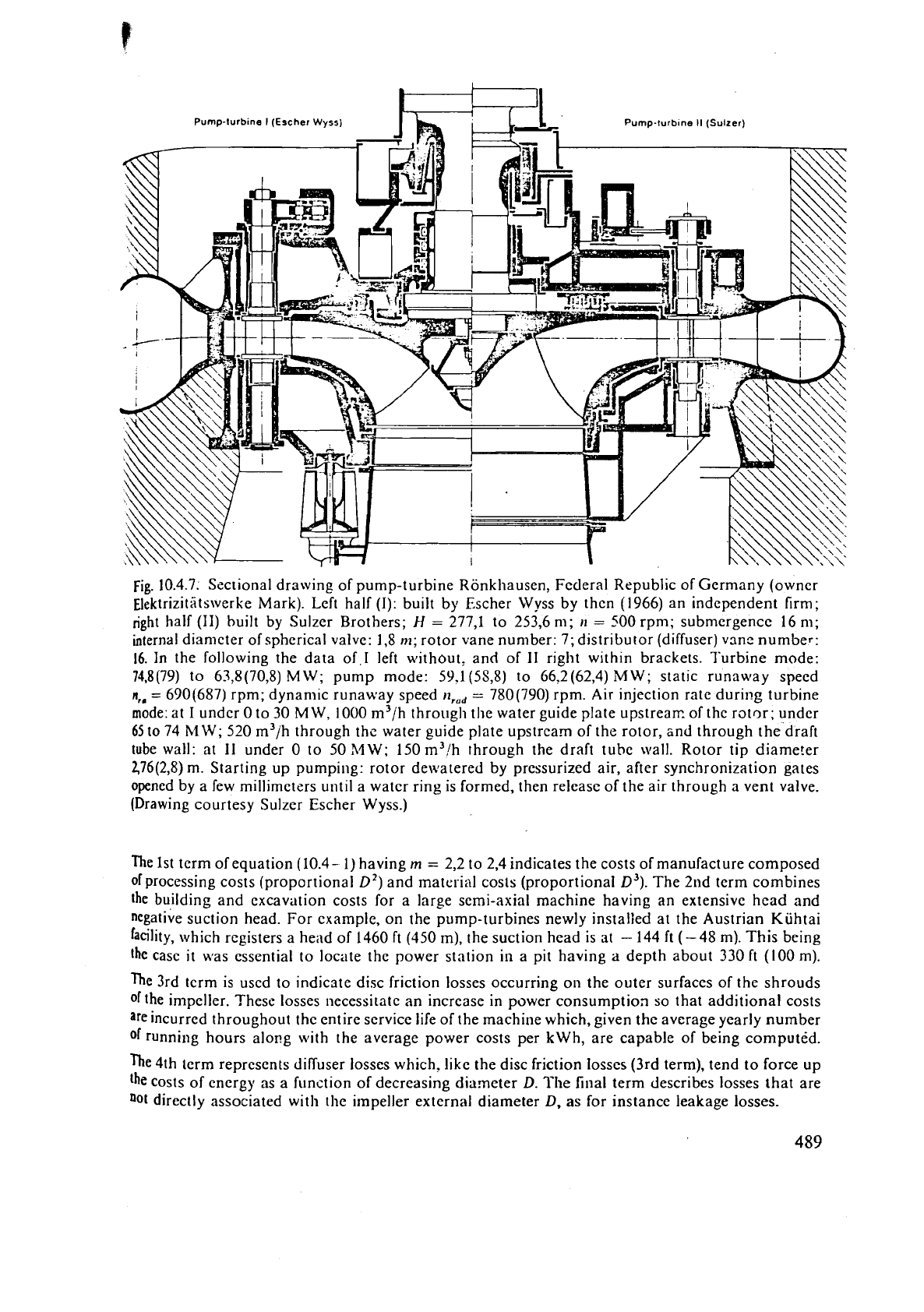
Fig. 10.4.7. Sectional drawing of pump-turbine Ronkhausen, Federal Republic of Germany (owner
ElektrizitLtswerke Mark). Left half
(I):
built by Escher Wyss by thcn (1966) an independent firm;
right half
(11)
built by Sulzer Brothers;
H
=
277,l to 253,6
m;
11
=
500 rpm; submergence 16 m;
internal diameter of spherical valve:
l,S
rn;
rotor vane number: 7; distributor (diffuser) vane number:
16.
In the following the data of
I
left without, and of
I1
right within brackets. Turbine mode:
74,8(79) to 63,8(70,8) MW; pump mode: 59.1 (58,s) to 66.2(62,4)
MW;
static runaway speed
n,,
=
690(687) rpm; dynamic runaway speed
rr,,,
=
780(790) rpm. Air injection rate during turbine
mode: at
1
undcr 0 to 30
M
W,
1000 m3/h through the water guide plate upstrearr. of the rotor; under
65
to 74
MW;
520 m3/h through the water guide plate upstrcam of the rotor, and through the-draft
rube
wall: at
I1
under 0 to 50
MW;
150 m3ih through the draft tube wall. Rotor tip diameter
2,76(2,8)
m.
Starting up pumping: rotor dewatered by pressurized air, after synchronization gates
opened by a few millimeters until a water ring is formed, then release of the air through a vent valve.
(Drawing courtesy
Sulzer Escher Wyss.)
The 1st term ofequation (10.4-
1)
having
m
=
2,2 to 2,4 indicates the costs of manufacture composed
of processing costs (proportional
D~)
and material costs (proportional
D~).
The 2nd term combines
the building and excavation costs for
a
large semi-axial machine having an extensive head and
negative suction head. For
cxample, on the pump-turbines newly installed at the Austrian Kuhtai
facility, which registers a head of 1460
ft
(450 m), the suction head is at
-
144 ft (-48 m). This being
the case it was essential to locate the power station in a pit having a depth about 330
ft
(I00 m).
The 3rd term is used to indicate disc friction losses occurring on the outer surfaces of the shrouds
of the impeller. These losses necessitate an increase in power consumption so that additional costs
are incurred throughout thc entire service life of the machine which, given thc average yearly number
of
running hours alor?g with the average power costs per kwh, are capable of being computed.
The 4th term reprcscnts diffuser losses which, like the disc friction losses (3rd term), tend to force up
the costs of energy as a function of decreasing diameter
D.
The final term describes losses that are
"1
directly associated with the impeller external diameter
D,
as for instance leakage losses.

Fip.
10.4
8.
Elc\ ation
of
till:
pump-turbir:~ sct \;i.lnden.
2.
Lu~cmburg. [Oi\.ncr Societk d'~lectricitk
d'O:tr)
PUT
built
b!
thc c~?ll;iboration
of
\'ci~h
and
Si~lzcr Escher
Wyss.
11
=
333.3
rpm. Turbining:
H,,
=
2S6
nl:
c,,
:,=
105.8
I\I\i.:
Pumpiu~:
tl
=
37!
to
294
m;
P
=
115
to
202.5
XIW.
Rotor:
I)
=
2.446
rn. Gritcs opcratcd
by
sinele scr\.omotors. Axial !hrust derived into tlic
shy
vanes
via
3
trunc:~tcd cone and the hc:~d co\cr,Initi:~l fo111
of
niis:~lig~icd
gates
wit11 rotor. Altcrnutor klcilitating
:\n
.IS\ n~hro~ivils start
of
pu~npi~ig wt~li
;I
lillcd machine (Drawing courtesy
Voith.)
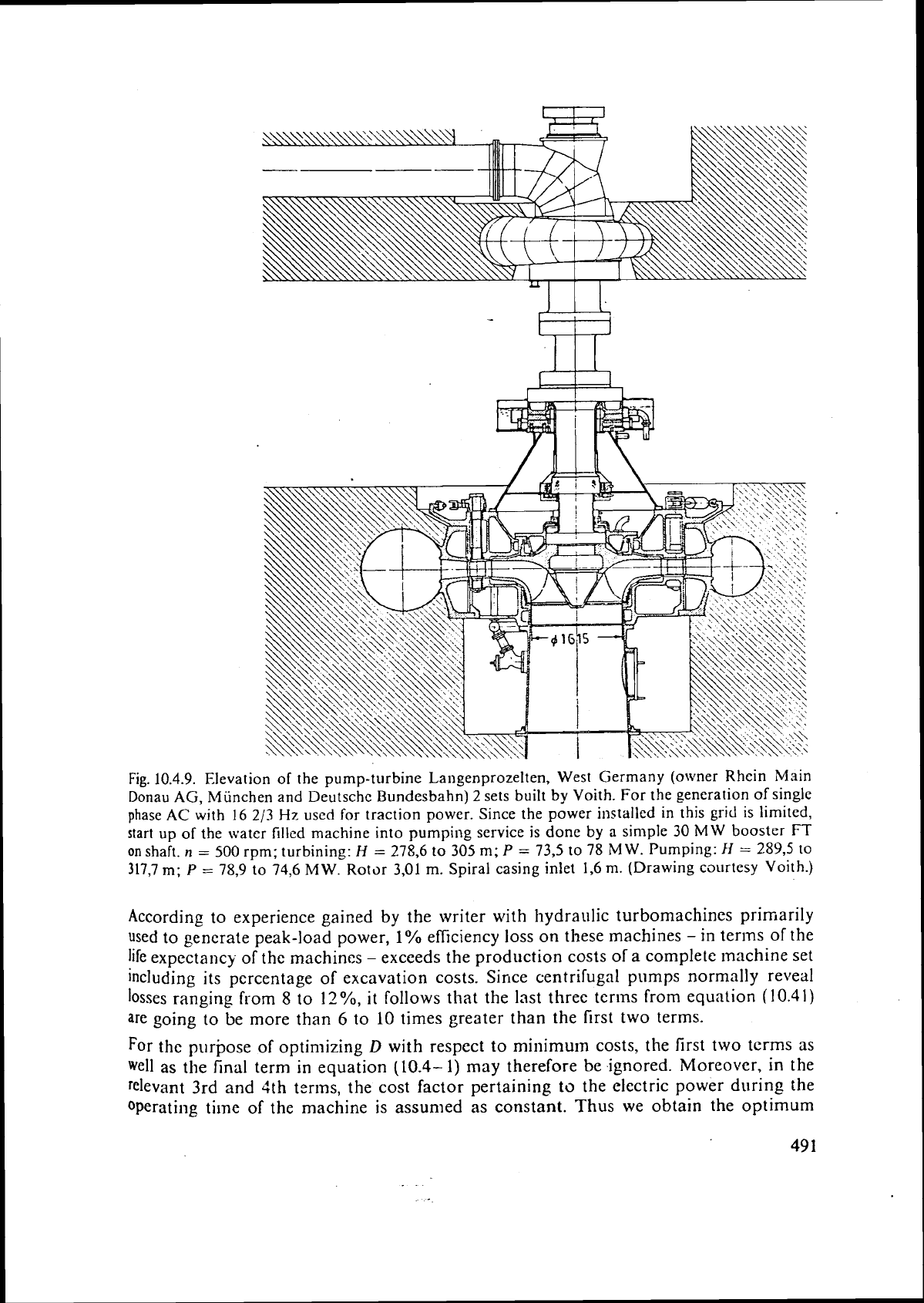
Fig. 10.4.9. Elevation of the pump-turbine Langenprozelten, West Germany (o\vner Rhein Main
Donau
AG,
Miinchen and Deutsche Bundesbahn) 2 sets built by Voith. For the generation of single
phase
AC
with 16 213
Hz
used for traction power. Since the power
installed
in this grid is limited,
start up of the
\vater filled machine into pumping service is done
by
a
sinlple 30 M
W
booster
FT
on
shaft.
n
=
500 rpm; turbining:
H
=
278,6 to 305 m;
P
=
73,5 to 78 MW. Pumping:
FI
=
289,5
to
317,7 m;
P
=
78,9 to 74,6 MW. Rotor
3,01
m.
Spiral casing inlet 1,6 m. (Drawing courtesy Voith.)
According to experience gained by the writer with hydraulic turbomachines primarily
used to generate peak-load power,
1
%
efficiency loss on tllese machines
-
in terms of the
life
expectancy of the machines
-
exceeds the production costs of a complete machine set
including its percentage of excavation costs. Since centrifugal pumps normally reveal
losses ranging from
8
to
12%,
it follows that the last three terms from equation
(10.41)
are going to be more than
6
to
10
times greater than the first two terms.
For
the purpose of optiniizing
D
with respect to minimum costs, the first two terms as
well
as the final term in equation
(10.4-
1)
may therefore be ignored. Moreover, in the
relevant 3rd and 4th terms, the cost factor pertaining
to
the electric power during the
operating time of the machine is assumed as constant. Thus we obtain the optimum
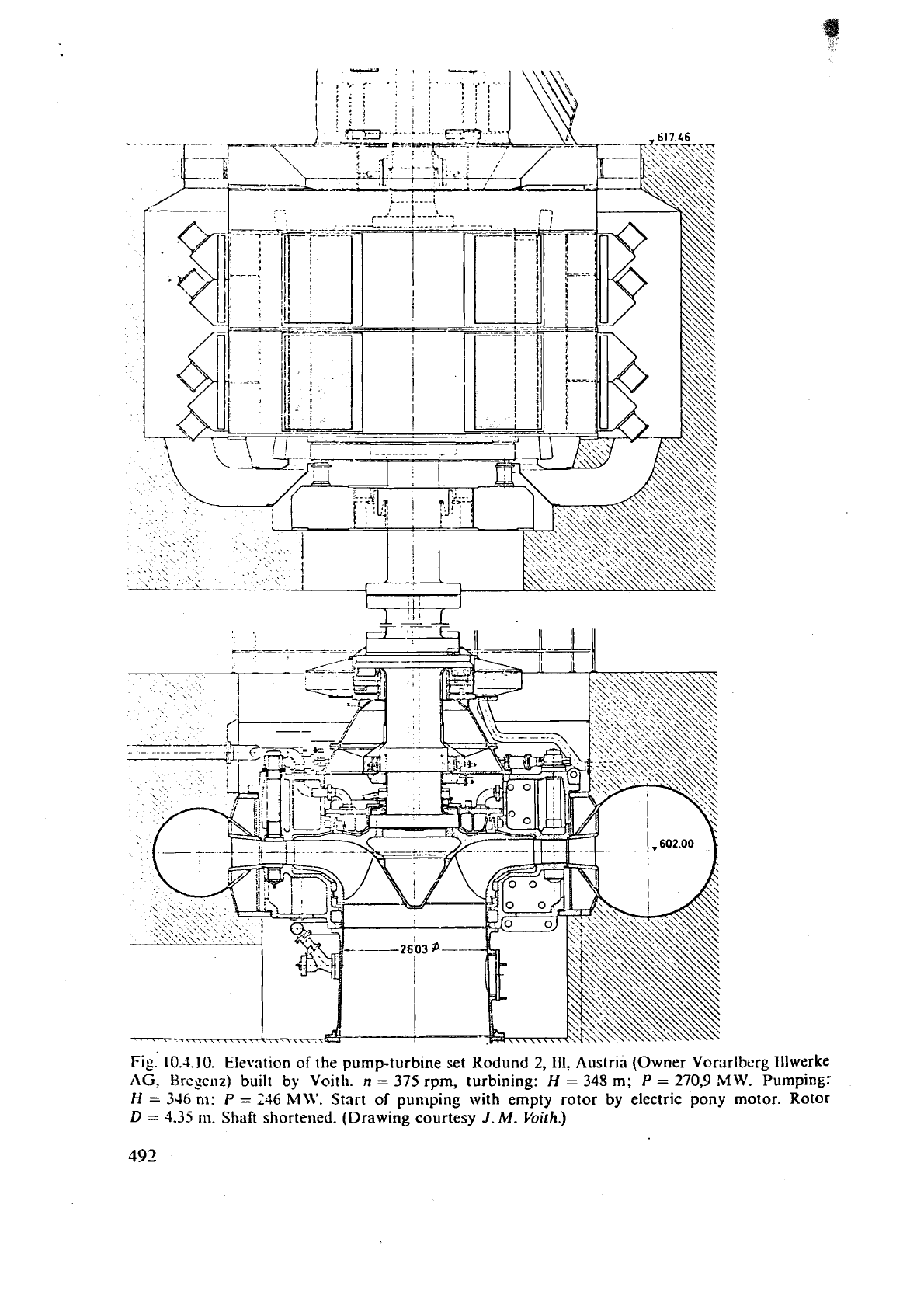
Fig.
10.4.10. Elevation of the pump-turbine set Kodund
2,
111, Austria (Owner Vorarlberg lllwerke
IIG,
Brcgcnz)
built
by
Voith.
n
=
375 rpm, turbining:
H
=
343
m;
P
=
270,9
MW.
Pumping:
H
=
346
m:
P
=
246
hl\l'.
Start of pumping with empty rotor
by
electric pony motor. Rotor
D
=
435
m.
Shaft shortened. (Drawing courtesy
J.
M.
Voith.)
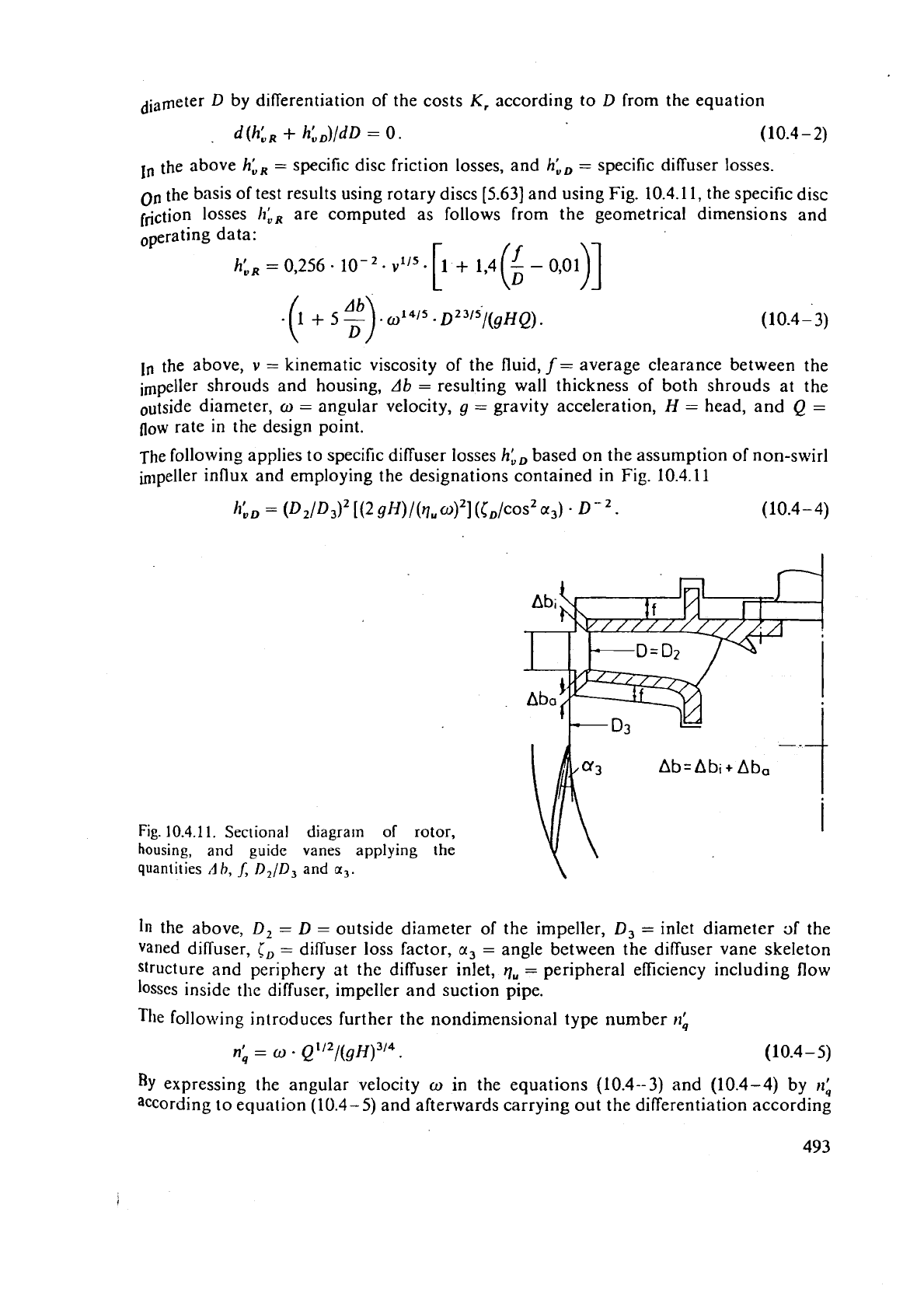
diameter
D
by differentiation of the costs
K,
according to
D
from the equation
In
the above
h:,
=
specific disc friction losses, and
h:,
=
specific diffuser losses.
On
the basis of test results using rotary discs [5.63] and using Fig. 10.4.1 I, the specific disc
friction losses
It:,
are computed as follows from the geometrical dimensions and
operating data:
hLR
=
0,256
-
v"~.
In
the above,
v
=
kinematic viscosity of the fluid,
f
=
average clearance between the
impeller shrouds and housing,
Ab
=
resulting wall thickness of both shrouds at the
outside diameter,
o
=
angular velocity,
g
=
gravity acceleration,
11
=
head, and
Q
=
flow
rate in the design point.
The following applies to specific diffuser losses
h:,
based on the assumption of non-swirl
impeller influx and employing the designations contained in Fig. 10.4.1 1
Fig.10.4.11.
Sectional diagram
of
rotor,
housing,
and
guide
vanes
applying
the
quantities
d
h,
/,
D,
-- -
-
/D,
and
a,.
In
the above,
D,
=
D
=
outside diameter of the impeller,
D,
=
inlet diameter af the
vaned diffuser,
("
=
diffuser loss factor,
a,
=
angle between the diffuser vane skeleton
structure and periphery at the diffuser inlet,
qu
=
peripheral efficiency including flow
losses inside the diffuser, impeller and suction pipe.
The following introduces further the nondimensional type number
11,
BY
expressing the angular velocity
o
in the equations (10.4--3) and (10.4-4) by
s;
according to equation (10.4-5) and afterwards carrying out the differentiation according

In
tllc
abut-c.
C
rcprcscnrs
a
nondilncnsionnl p;lr:;lr;ictcr which in ti~rn
is
dependent
on
nondimcnsio~lrl! opcr;tting data and gcometric:~l rclatiol~sliips:
It
should
be
noted
t
hiit
/jD.
Ahlll
and
D2/D3
ore ~ivcn qt.~antities, even
if
they contain
D
=
D,.
he
same
applies to
c,,
11,
and
x,,
these libewisc being given.
From
equa~ions
(
10.4
---
6).
and (10.4
-
7)
it
will be observed
that
D,,
is largely dependent
on the type ni~!nber
il;
ivliich is defificd in eq.
(10.4-
5).
The
type nan~ber
il;
irsclf is likewise cap:lblc of being optiiiiizcd as
a
fur?ction of
geomet-
ric;il d;\~a. loss
;inti
c:r\it;~tion cocfticients.
This
is
described in greater detail in
the
following scction.
10.4.3.
Sew
forrnu!a
for
the
type
nl~mber
of
il
semi-asi:11
cefitrifiigal
pump
impeller
10.4.3.1.
Optin~um
diameter
of
the inlpcllcr eye with respect to internal
losses
li1.4.3.1.
I.
Itnpeller loss
F'urthcr computation
is
bascct on the followil~g simple assumptions (see also Fig. 10.4.12)
In
the above.
c*
=
3bsullite speed,
H,
=
relative speed.
/I
=
angle between relative speed
and circunlfsrei~ce.
c.,,
=
circunlft.renti;i! co~nporient of
c..
and
c,,
=.
meridian component
of
L..
Illdel
1
iridic.:!tch the irnyeller inlet
:i11J
indes
2
the impeller outlet. All quantities are
rqean
\.al:ic~
ascerr'iined between.
both
.\liroud and Iii~b,
and
the vane pressure and
suction faces. The
i
;lilts are assuned
as
bzil~g
perpendicularly arranged on the impeller
shroud
and hub.
The loss
of
input insid; t11c impeller passage is computed to the following:
P,
=
rv
.
F,,
in
\vllich
case
F;
';-
resistance force inside tile iri~peller passage parallel
to
lo.
Along the vanes
n
co~lstrin;
force
per unit of length
F,
is inte~ided to act perpendicularly
to the
v;:nc
t~riit
35
011iIi11t'd
ill
Fis.
10.4.12.
The circu~nferential component of this force,
which acts upon
;i
\.:i!ir
unit of r;ldiai csteilsion
clr,
is computed as follows:
dF,
=
I.',
-
(1,:
cos
!i.
11
rcpreselits the
mean
an& bztween a mean meridian flowline and
the
radius.
Thus
thc pcriphsrnl input
is
obtained necessary for the propulsion of an impeller
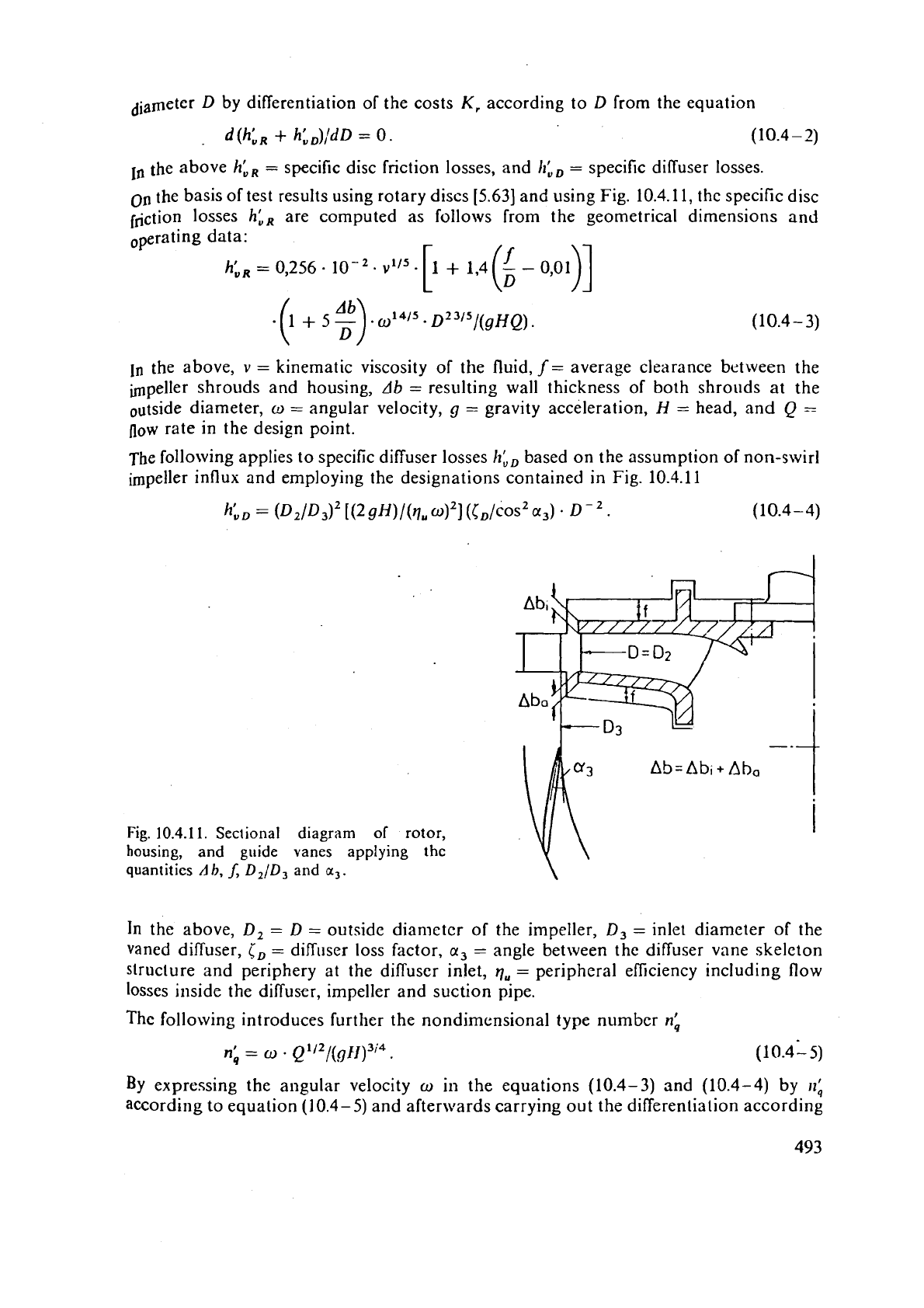
diameter
D
by differentiation of the costs
K,
according
to
D
from the equation
In
the above
h:,
=
specific disc friction losses, and
h:,
=
specific diffuser losses.
On
the basis of test results using rotary discs [5.63] and using Fig. 10.4.11, the specific disc
friction losses
h:,
are computed as follows from the geometrical dimensions and
operating data:
&,
=
0,256. 10-*.~''~-
In
the above,
v
=
kinematic viscosity of the fluid,
f
=
average clearance between the
impeller shrouds and housing,
Ab
=
resulting wall thickness of both shrouds at the
outside diameter,
CL)
=
angular velocity,
g
=
gravity acceleration,
H
=
head, and
Q
-
flow
rate in the design point.
The following applies to specific diffuser losses
hi,
based on the assumption of non-swirl
impeller influx and employing the designations contained in Fig. 10.4.1 1
Ab=Ab,+
Ah,
Fig.
10.4.1
1.
Sectional diagram
of
rotor,
housing,
and
guide
vanes
applying
the
i
quantities
Ah,
f,
DJD,
and
a,.
In
the above,
D,
=
D
=
outside diameter of the impeller,
D,
=
inlet diameter of the
vaned diffuser,
[,
=
diffuser loss factor,
a,
=
angle between the diffuser vane skeleton
structure and periphery at the diffuser inlet,
q,
=
peripheral efficiency including flow
losses inside the diffuser, impeller and suction pipe.
The following introduces further the nondimensional type number
nb
By
expressing the angular velocity
o
in the equations (10.4-3) and (10.4-4) by
11:
according to equation (10.4-5) and afterwards carrying out the differentiation according
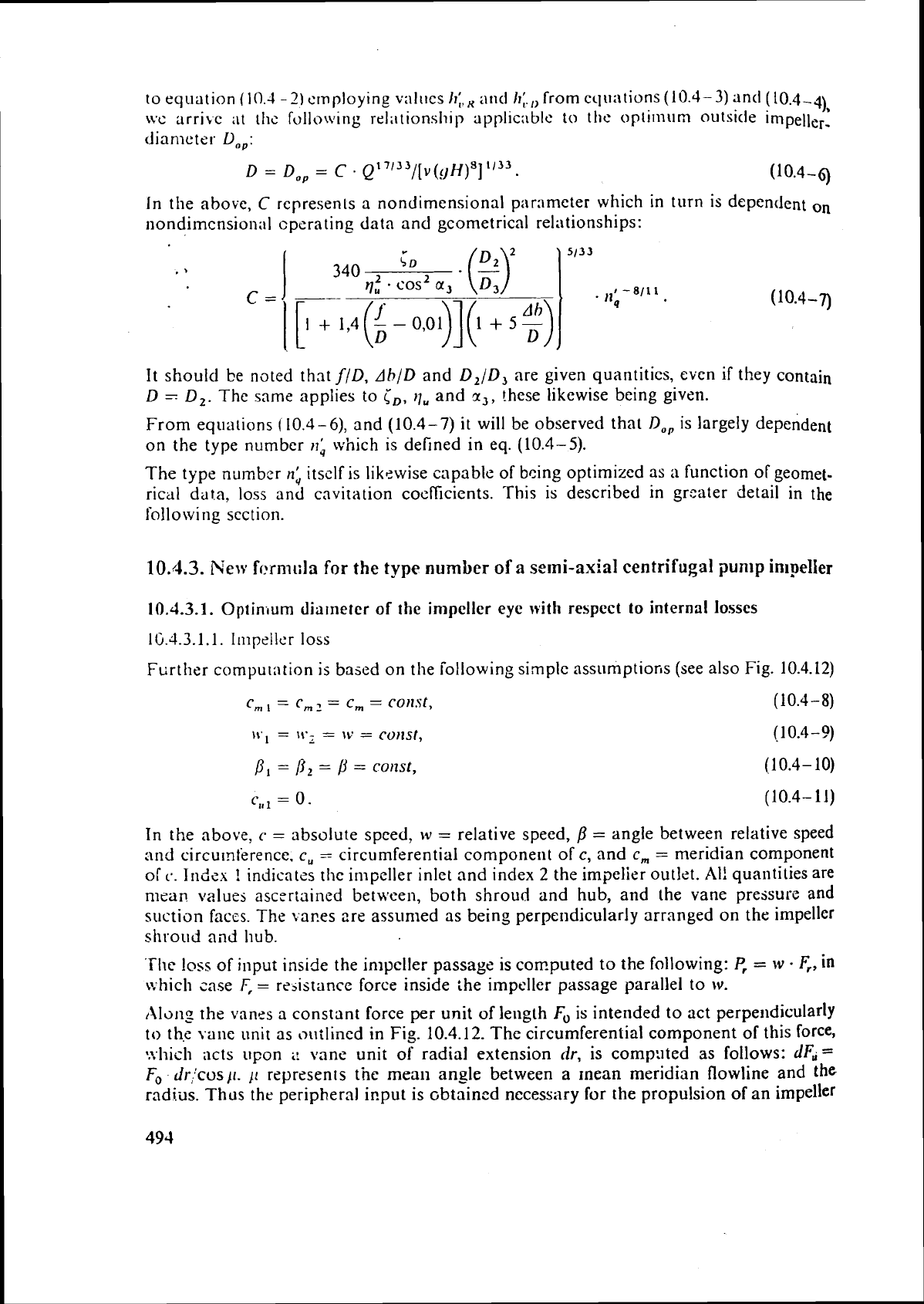
to cqoation
(10.4
-2)
ctnploying v;ilrles
II:,~
and
A:.,,
from eqll:~tions
(10.4-3)
and (10.4-4)
nc
arribc
;it
thc following reli1tions11il-1 app1ic;tblc
to
thc opti~nnm outsicle impeller:
diameter
L),,:
D
=
D
=
C
.
~1713J
8
1/33
0
P
I[v(~H)
I
-
(10.4-6)
In the above,
C
represents a nondimensional par:lmeter which in turn is dependent
on
tlondimcnsional cpzrating data and gcometrical relrltionships:
It should be noted that f/D,
AhlD
and D2/D3 are given quantities, even
if
they contain
D
-
D,.
The same applies to
i,,
11,
and
rr,,
!hese likewise being given.
From equations
I
10.4
-
6),
and
(10.4-
7)
it will be observed that
Do,
is largely dependent
on the type number
n;
which is defined in eq. (10.4-5).
The
type numbx
n;
itsclf is likewise capable of bcing optimized as
a
function of geomet-
rical data, loss and cavitation coefficients. This is described in
grcater detail in the
followi~ig section.
10.4.3.
New
formula
for
the
type
number
of
a
semi-axial
centrifugal
pump
in~peller
10.4.3.1.
Optinium
diameter
of
the
impeller
eye
with
respect
to internal losses
lG.4.3.1.1.
Iu~peilcr loss
F~rther computation is based on the following simple assumptions (see also Fig. 10.4.12)
C,,
I
=
C,,
=
C,
=
COll.St,
=
I\':
=
\V
=
COIlSt,
-
In
the
above,
c
=
absolute speed,
w
=
relative speed,
/?
=
angle between relative speed
and
circurnt'erence,
c,
=
circumferential component of
c,
and
c,
=
meridian component
of
c..
lridzx
1
indicatzs the impeller inlct and index
2
the impelier outlet.
Al!
quantities are
mean values ascertained between, both shroud and hub, and the vane pressure and
suction
faccs.
The
var?es ore assumed as being perpendicularly arranged on the impeller
shroud
and hub.
'Tile
loss
of input inside the impeller passage is computed to the following:
P,
=
w
-
F,,
in
\~;hicli case
I-;
=
~c~istance force inside the impeller passage parallel to
w.
tl\li)li~
the vanes
a
constant force per unit of length
F,
is intended to act perpelldicularl~
to
th.e vane unit 3s ~llilined in Fig. 10.4.12. The circumferential component of this force,
*?:hich acts upon
c
vans unit of radial extension
dr,
is comp:~ted
as
follows:
dFu=
F,
dr'cosli.
/i
represents the mean ansle between a mean meridian flowline and the
mdi.us. Thus the peripheral icput is ~btaincd necessilry for
the
propulsion of an impeller
